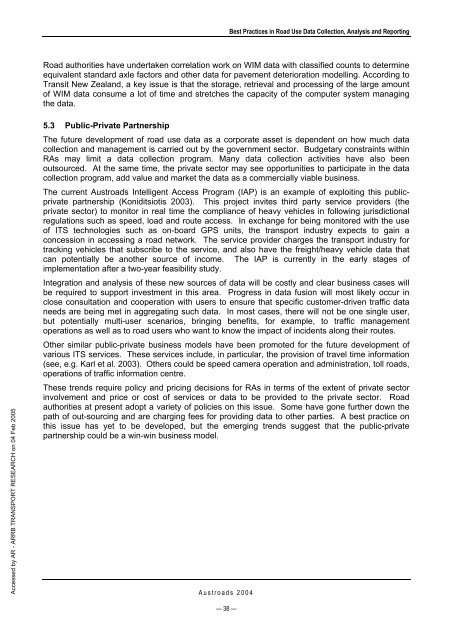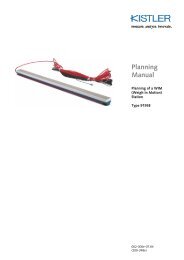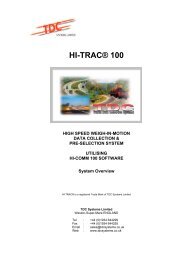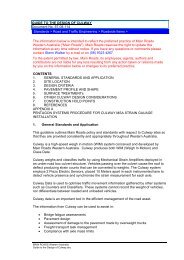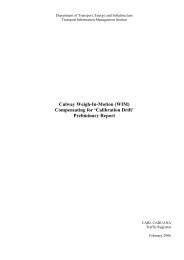AP-G84/04 Best practice in road use data collection, analysis ... - WIM
AP-G84/04 Best practice in road use data collection, analysis ... - WIM
AP-G84/04 Best practice in road use data collection, analysis ... - WIM
Create successful ePaper yourself
Turn your PDF publications into a flip-book with our unique Google optimized e-Paper software.
Accessed by AR - ARRB TRANSPORT RESEARCH on <strong>04</strong> Feb 2005<br />
Aust<strong>road</strong>s 20<strong>04</strong><br />
— 38 —<br />
<strong>Best</strong> Practices <strong>in</strong> Road Use Data Collection, Analysis and Report<strong>in</strong>g<br />
Road authorities have undertaken correlation work on <strong>WIM</strong> <strong>data</strong> with classified counts to determ<strong>in</strong>e<br />
equivalent standard axle factors and other <strong>data</strong> for pavement deterioration modell<strong>in</strong>g. Accord<strong>in</strong>g to<br />
Transit New Zealand, a key issue is that the storage, retrieval and process<strong>in</strong>g of the large amount<br />
of <strong>WIM</strong> <strong>data</strong> consume a lot of time and stretches the capacity of the computer system manag<strong>in</strong>g<br />
the <strong>data</strong>.<br />
5.3 Public-Private Partnership<br />
The future development of <strong>road</strong> <strong>use</strong> <strong>data</strong> as a corporate asset is dependent on how much <strong>data</strong><br />
<strong>collection</strong> and management is carried out by the government sector. Budgetary constra<strong>in</strong>ts with<strong>in</strong><br />
RAs may limit a <strong>data</strong> <strong>collection</strong> program. Many <strong>data</strong> <strong>collection</strong> activities have also been<br />
outsourced. At the same time, the private sector may see opportunities to participate <strong>in</strong> the <strong>data</strong><br />
<strong>collection</strong> program, add value and market the <strong>data</strong> as a commercially viable bus<strong>in</strong>ess.<br />
The current Aust<strong>road</strong>s Intelligent Access Program (I<strong>AP</strong>) is an example of exploit<strong>in</strong>g this publicprivate<br />
partnership (Koniditsiotis 2003). This project <strong>in</strong>vites third party service providers (the<br />
private sector) to monitor <strong>in</strong> real time the compliance of heavy vehicles <strong>in</strong> follow<strong>in</strong>g jurisdictional<br />
regulations such as speed, load and route access. In exchange for be<strong>in</strong>g monitored with the <strong>use</strong><br />
of ITS technologies such as on-board GPS units, the transport <strong>in</strong>dustry expects to ga<strong>in</strong> a<br />
concession <strong>in</strong> access<strong>in</strong>g a <strong>road</strong> network. The service provider charges the transport <strong>in</strong>dustry for<br />
track<strong>in</strong>g vehicles that subscribe to the service, and also have the freight/heavy vehicle <strong>data</strong> that<br />
can potentially be another source of <strong>in</strong>come. The I<strong>AP</strong> is currently <strong>in</strong> the early stages of<br />
implementation after a two-year feasibility study.<br />
Integration and <strong>analysis</strong> of these new sources of <strong>data</strong> will be costly and clear bus<strong>in</strong>ess cases will<br />
be required to support <strong>in</strong>vestment <strong>in</strong> this area. Progress <strong>in</strong> <strong>data</strong> fusion will most likely occur <strong>in</strong><br />
close consultation and cooperation with <strong>use</strong>rs to ensure that specific customer-driven traffic <strong>data</strong><br />
needs are be<strong>in</strong>g met <strong>in</strong> aggregat<strong>in</strong>g such <strong>data</strong>. In most cases, there will not be one s<strong>in</strong>gle <strong>use</strong>r,<br />
but potentially multi-<strong>use</strong>r scenarios, br<strong>in</strong>g<strong>in</strong>g benefits, for example, to traffic management<br />
operations as well as to <strong>road</strong> <strong>use</strong>rs who want to know the impact of <strong>in</strong>cidents along their routes.<br />
Other similar public-private bus<strong>in</strong>ess models have been promoted for the future development of<br />
various ITS services. These services <strong>in</strong>clude, <strong>in</strong> particular, the provision of travel time <strong>in</strong>formation<br />
(see, e.g. Karl et al. 2003). Others could be speed camera operation and adm<strong>in</strong>istration, toll <strong>road</strong>s,<br />
operations of traffic <strong>in</strong>formation centre.<br />
These trends require policy and pric<strong>in</strong>g decisions for RAs <strong>in</strong> terms of the extent of private sector<br />
<strong>in</strong>volvement and price or cost of services or <strong>data</strong> to be provided to the private sector. Road<br />
authorities at present adopt a variety of policies on this issue. Some have gone further down the<br />
path of out-sourc<strong>in</strong>g and are charg<strong>in</strong>g fees for provid<strong>in</strong>g <strong>data</strong> to other parties. A best <strong>practice</strong> on<br />
this issue has yet to be developed, but the emerg<strong>in</strong>g trends suggest that the public-private<br />
partnership could be a w<strong>in</strong>-w<strong>in</strong> bus<strong>in</strong>ess model.


